Briefly: In our opinion, full (150% of the regular full position) speculative short positions in gold, silver and mining stocks are justified from the risk/reward perspective at the moment of publishing this alert.
Not much happened with the price of gold, silver and mining stocks yesterday, but quite a lot happened in the USD Index. Since this is one of the two key fundamental (the USD is also important technically) drivers of the price of gold (the other one being real interest rates), the importance of the USD action should not be something that is ignored. How is the USD’s decline and the visible breakdown below the rising support line likely to impact the precious metals market in the near future?
Let’s take a look at the charts for details (chart courtesy of http://stockcharts.com).
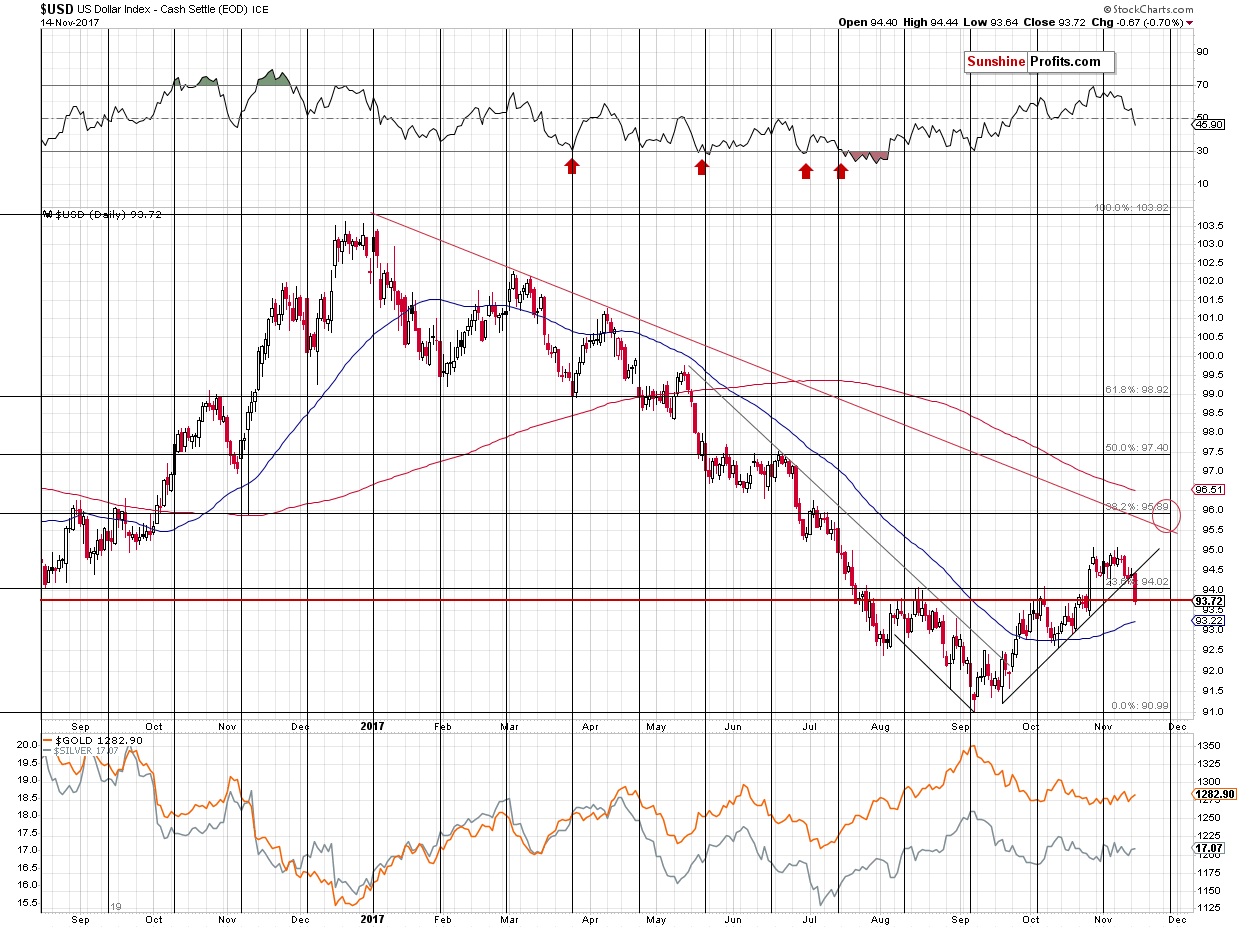
In yesterday’s alert, we commented on the above USD Index chart in the following way:
In yesterday’s alert, we wrote that the USD Index moved to the rising short-term support line without breaking below it. Consequently, it was likely to bounce and continue its rally. The 95.89 still served as the most likely short-term target.
We can say exactly the same thing based on yesterday’s non-performance. Nothing really changed and the USD is still likely to rally based on the proximity of the rising support line and the target area remains up-to-date as well.
In today’s pre-market trading, the USD Index moved a bit below the rising support line, but not below the early October high – the key breakout was not invalidated and the breakdown below the rising support line is small and not confirmed by daily closing prices. Consequently, it doesn’t seem that it changes anything. Besides, since gold and silver are down today (at least at the moment of writing these words) even despite USD’s small decline, the implications are bearish for the former anyway.
The USD Index finally closed the session below the October and August highs in terms of the intraday prices, however, there was no visible breakdown below the same highs in terms of the daily closing prices.
So, was the breakdown really a game changer? The above and the additional detail seem to invalidate this theory at least at this time. The additional detail is that the current rally (that started in September) has been to some extent a reflection of the previous months of declines. The line that’s analogous to the rising support line that was just broken is the declining line based on August and September lows. The early August low was also visibly below the line and a reflection thereof would be a temporary move below the current support line – that’s what we saw yesterday. The above analogy is not very clear so it’s not very strong, but still, that’s something to keep in mind.
The most important thing about yesterday’s decline in the fact that metals barely reacted to it and miners even managed to close below the previous day’s low. Since the reaction was so small and even negative in the case of miners, should one really be expecting the PMs to soar if the USD declines again? Not really.
But why did the USD Index decline at all? It wasn’t about weakness in the USD per se – it was about the strength in the euro. The Japanese yen has barely moved and at the same time gold’s price in terms of the euro declined sharply.
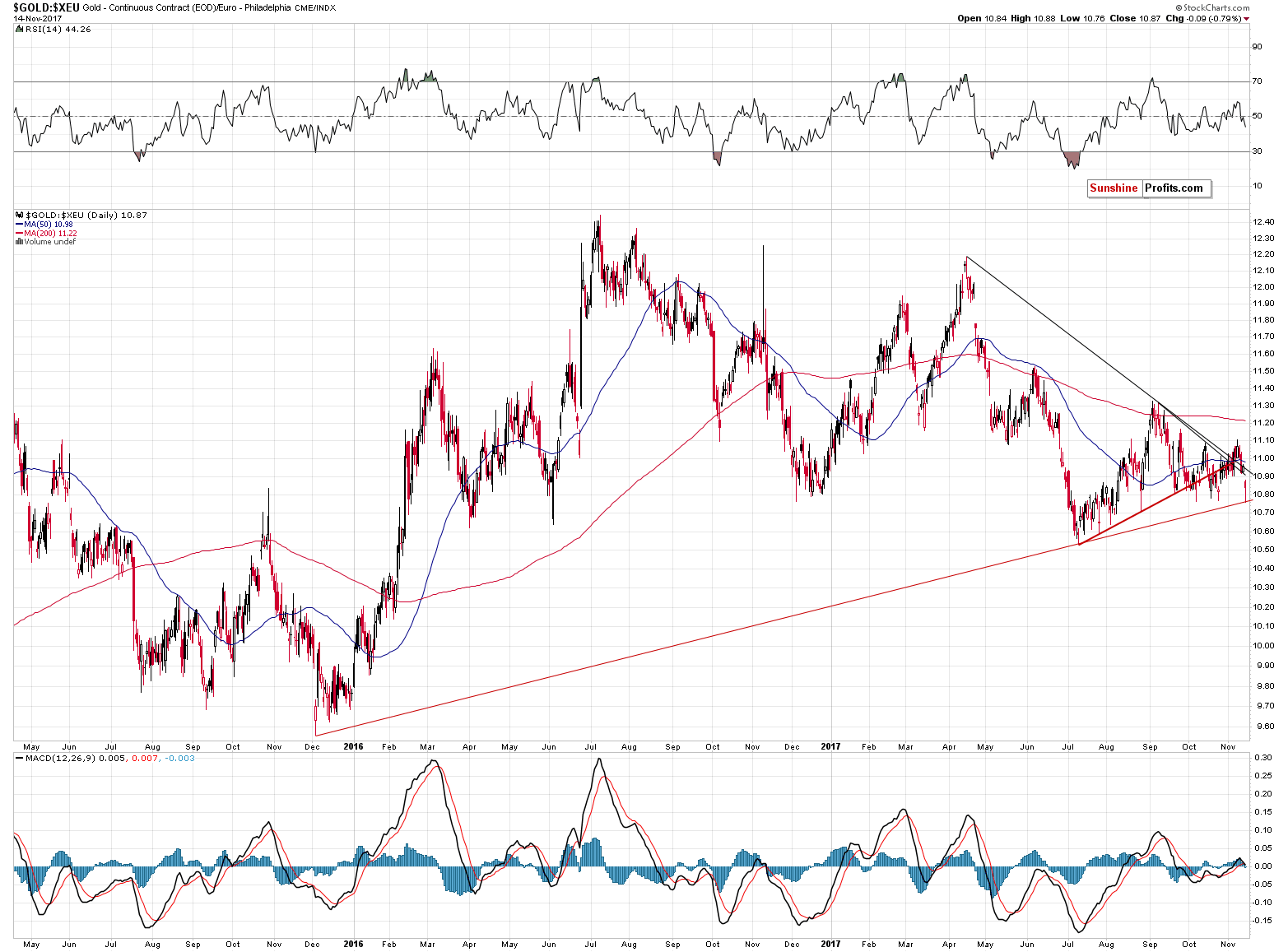
In terms of the European currency, the value of gold moved temporarily below the September and October lows and the MACD indicator flashed a small (but still) sell signal.
The above is not a bullish, but rather bearish piece of news for gold.
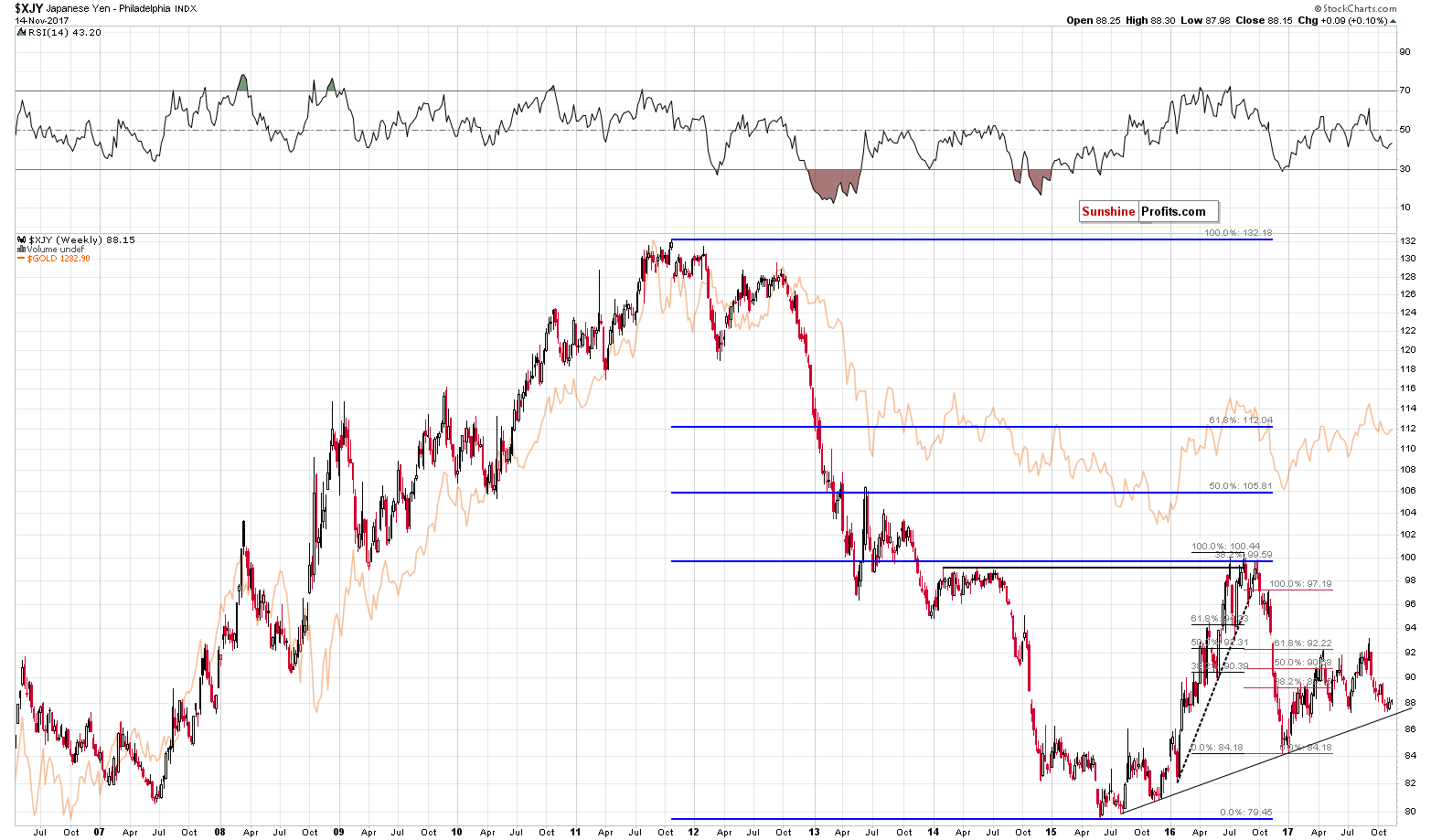
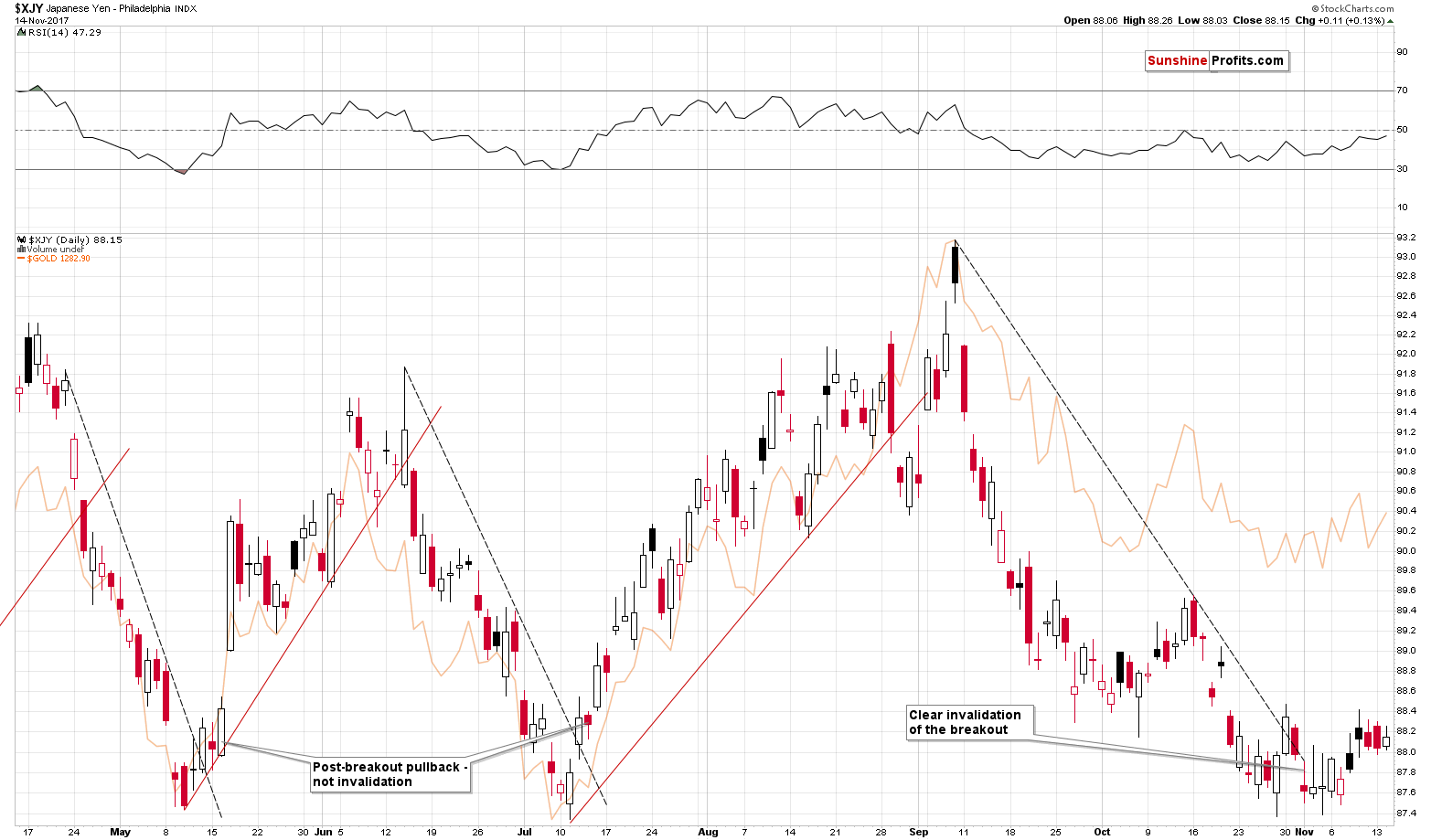
The value of the Japanese yen relative to the U.S. dollar didn’t rally but it didn’t slide either. However, it’s quite clear that what’s been taking place in the past few weeks is very different from what happened when the yen bottomed in May and July earlier this year.
The yen seems to be gathering strength to finally move lower and decline below the rising medium-term support line based on the 2015 and 2016 lows. If it manages to do so, the next major target will be the 2016 bottom. Since gold and yen often move in tandem, the above could result in gold moving to its 2016 bottom as well. In other words, the action in the yen (or more precisely, the lack thereof) is something that could finally result in gold moving about $150 lower.
So, is the current impact of the forex market on the price of gold currently bullish? No, despite yesterday’s decline in the USD, the opposite seems to be the case.
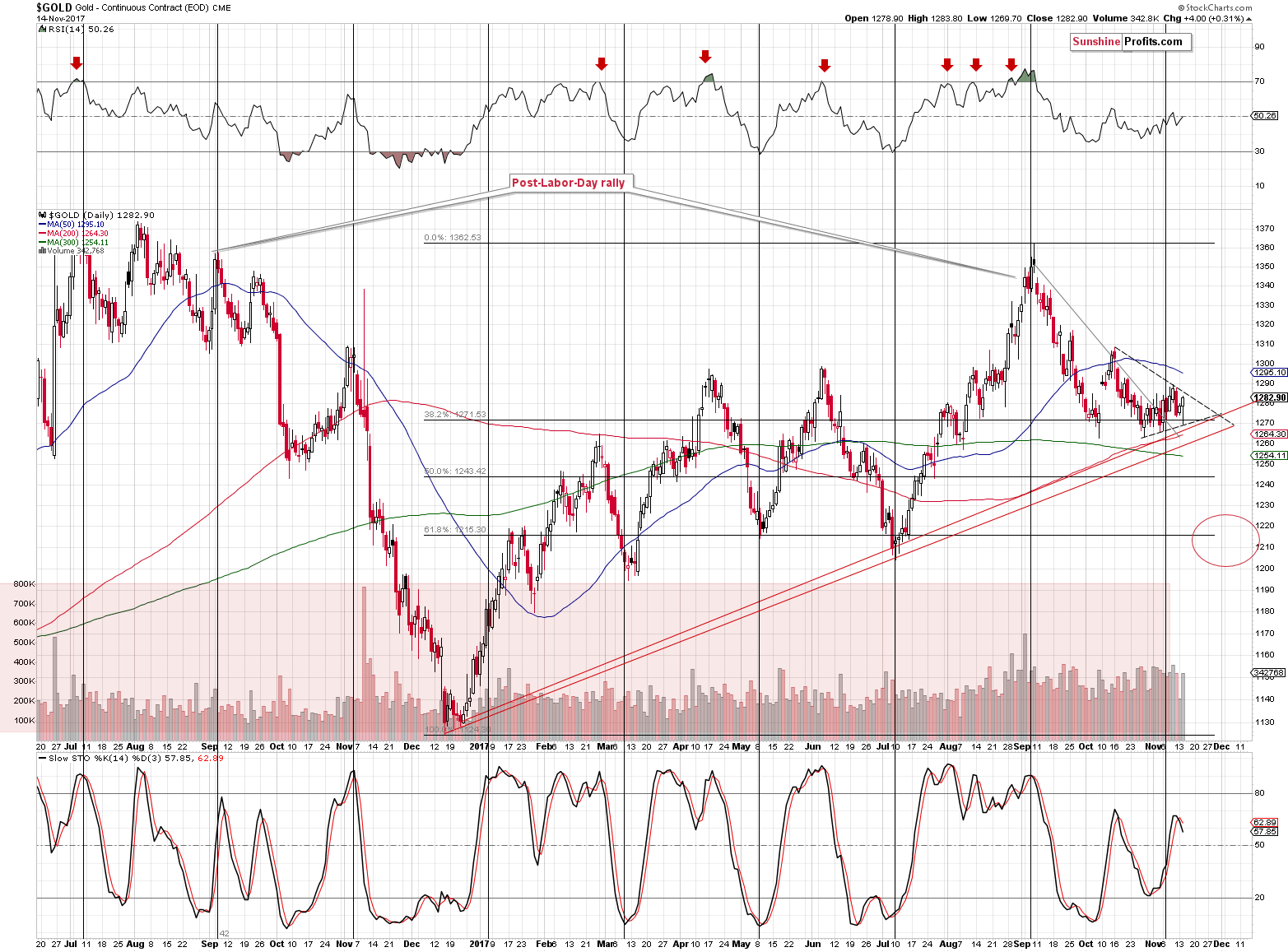
As we wrote earlier, nothing really changed in the case of the price of gold. The sell signal from the Stochastic indicator wasn’t invalidated so the bearish implications thereof remain in place.
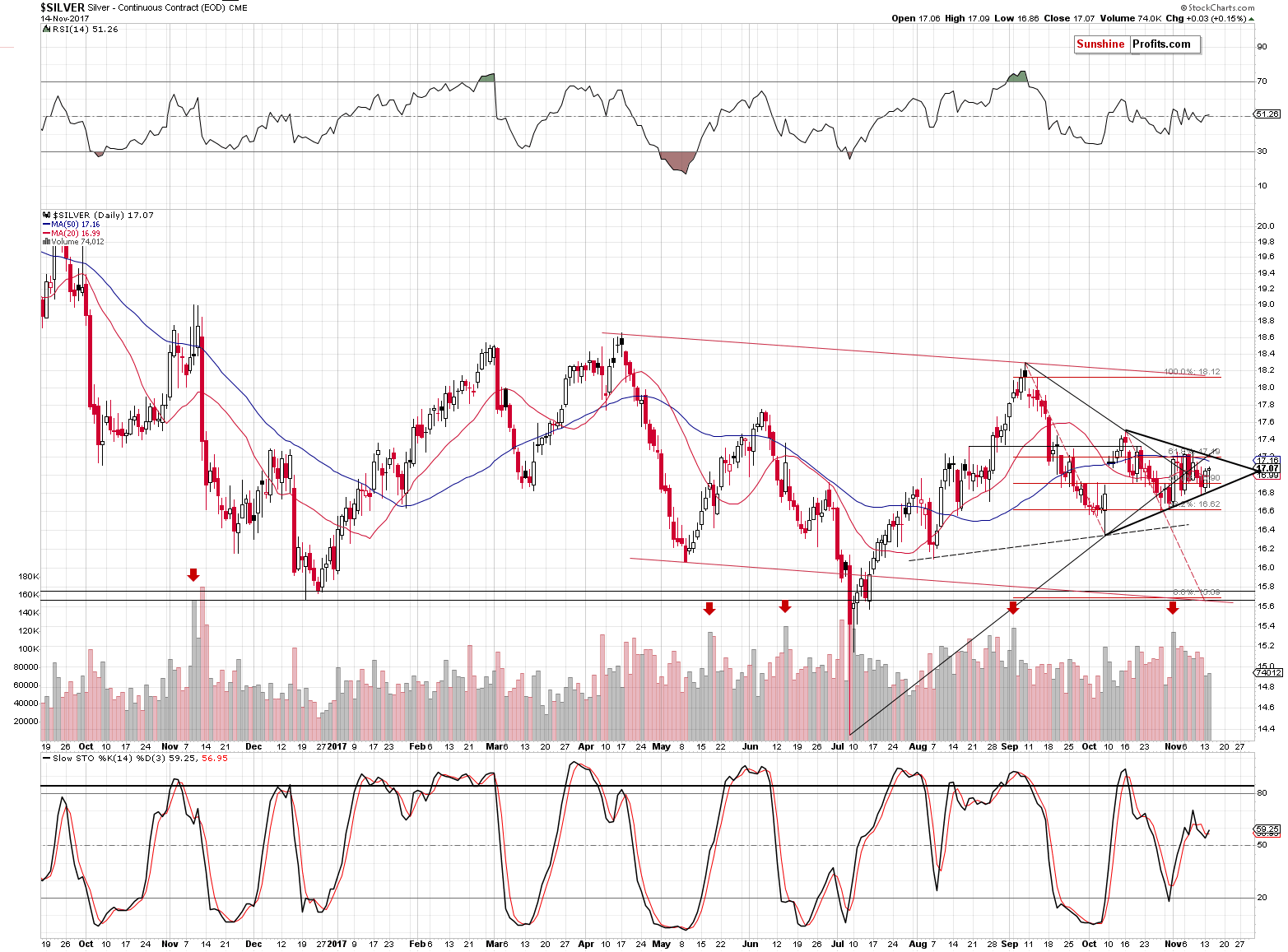
In yesterday’s alert, we wrote the following on silver:
Silver moved higher on low volume, which made the rally rather insignificant. We didn’t have to wait long for the confirmation as silver declined in today’s pre-market trading and moved back to where it was before yesterday’s intraday rally. The sell signal from the Stochastic indicator remains in place and our comments on it remain up-to-date as well:
The sell signal from the Stochastic indicator is even clearer based on Friday’s move lower, so the implications are bearish. In fact, there were only three other cases visible on the above chart when the Stochastic flashed visible sell signals (moving below its red signal line) while not being above the 80 level, but below it. They all were followed by very sharp declines: the late September 2016 signal was followed by a sharp slide in early October, the mid-November 2016 signal and declines are clearly visible and the same goes for the late-June 2017 decline that temporarily took silver below $15. Naturally, the implications are bearish.
Based on yesterday’s session the Stochastic indicator flashed a small buy signal – is it a strong bullish factor? Well, let’s see what happened when we saw something alike – there was only one similar case and that was almost exactly a year ago. Back then silver moved to the previous highs (even a bit above them), but the session that caused the Stochastic to move above its signal line was the session that ended the corrective rally. Silver plunged on the very next day and higher silver prices were not seen ever since. Again – are implications really bullish? We don’t think so.
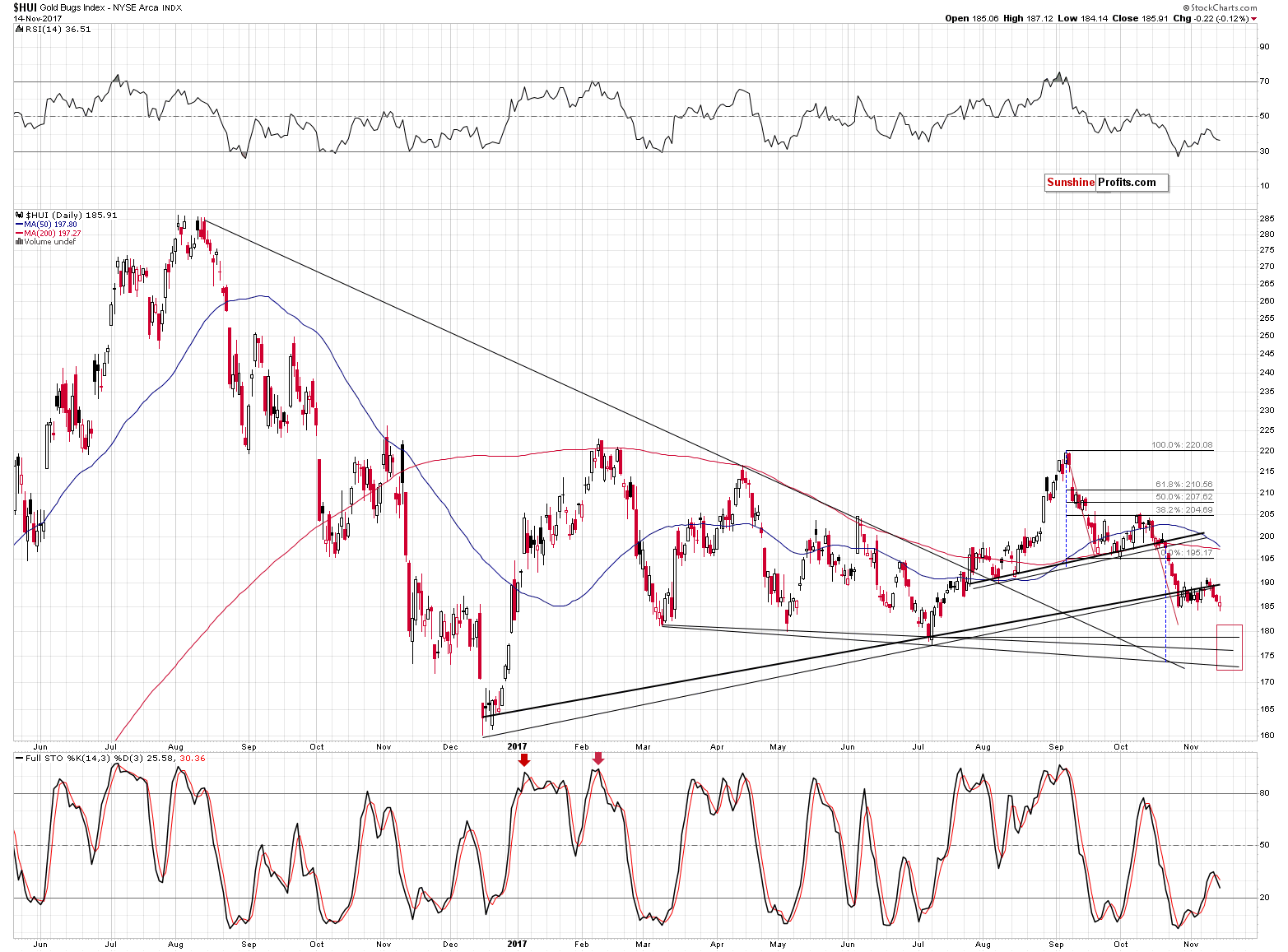
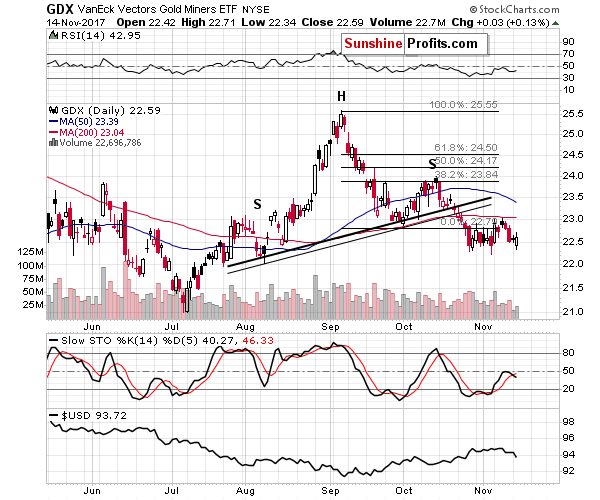
Gold stocks declined a bit while the GDX ETF moved a bit higher. None of the sell signals from the above were invalidated. The interesting factor here is that the volume on which GDX moved higher (just 3 cents, but still) yesterday was relatively low. That’s another confirmation that what happened yesterday was no show of strength in the precious metals market.
Summing up, the situation in the USD Index deteriorated, but not as significantly as it may seem at first sight and since the impact of yesterday’s decline on the prices of metals and miners was very limited, it doesn’t seem it’s a major bullish factor for the PMs. Conversely, since gold in terms of the euro declined sharply and the Japanese yen seems to be preparing for another sizable move lower, the outlook for metals and miners remains bearish.
The upcoming bottom is likely to be followed by a tradable rally, so we’re monitoring the market for confirmations and reliable signs of strength.
To be clear, the medium-term outlook remains bearish, especially that the analogy to the 2012-2013 decline remains in place and the previously discussed long-term signals remain in place: gold’s huge monthly volume, the analogy in the HUI Index, the analogy between the two most recent series of interest rate hikes, and the RSI signal from gold priced in the Japanese yen. However, it seems to be a good idea to take advantage of the upcoming short-term correction, should we get bullish confirmations from metals or miners.
As always, we will keep you – our subscribers – informed.
To summarize:
Trading capital (supplementary part of the portfolio; our opinion): Short positions (150% of the full position) in gold, silver and mining stocks are justified from the risk/reward perspective with the following stop-loss orders and exit price levels / profit-take orders:
- Gold: exit price: $1,218; stop-loss: $1,366; exit price for the DGLD ETN: $51.98; stop-loss for the DGLD ETN $38.74
- Silver: exit price: $15.82; stop-loss: $19.22; exit price for the DSLV ETN: $28.88; stop-loss for the DSLV ETN $17.93
- Mining stocks (price levels for the GDX ETF): exit price: $21.23; stop-loss: $26.34; exit price for the DUST ETF: $29.97; stop-loss for the DUST ETF $21.37
In case one wants to bet on junior mining stocks' prices (we do not suggest doing so – we think senior mining stocks are more predictable in the case of short-term trades – if one wants to do it anyway, we provide the details), here are the stop-loss details and exit prices:
- GDXJ ETF: exit price: $30.28; stop-loss: $45.31
- JDST ETF: exit price: $66.27; stop-loss: $43.12
Long-term capital (core part of the portfolio; our opinion): No positions (in other words: cash)
Insurance capital (core part of the portfolio; our opinion): Full position
Important Details for New Subscribers
Whether you already subscribed or not, we encourage you to find out how to make the most of our alerts and read our replies to the most common alert-and-gold-trading-related-questions.
Please note that the in the trading section we describe the situation for the day that the alert is posted. In other words, it we are writing about a speculative position, it means that it is up-to-date on the day it was posted. We are also featuring the initial target prices, so that you can decide whether keeping a position on a given day is something that is in tune with your approach (some moves are too small for medium-term traders and some might appear too big for day-traders).
Plus, you might want to read why our stop-loss orders are usually relatively far from the current price.
Please note that a full position doesn’t mean using all of the capital for a given trade. You will find details on our thoughts on gold portfolio structuring in the Key Insights section on our website.
As a reminder – “initial target price” means exactly that – an “initial” one, it’s not a price level at which we suggest closing positions. If this becomes the case (like it did in the previous trade) we will refer to these levels as levels of exit orders (exactly as we’ve done previously). Stop-loss levels, however, are naturally not “initial”, but something that, in our opinion, might be entered as an order.
Since it is impossible to synchronize target prices and stop-loss levels for all the ETFs and ETNs with the main markets that we provide these levels for (gold, silver and mining stocks – the GDX ETF), the stop-loss levels and target prices for other ETNs and ETF (among other: UGLD, DGLD, USLV, DSLV, NUGT, DUST, JNUG, JDST) are provided as supplementary, and not as “final”. This means that if a stop-loss or a target level is reached for any of the “additional instruments” (DGLD for instance), but not for the “main instrument” (gold in this case), we will view positions in both gold and DGLD as still open and the stop-loss for DGLD would have to be moved lower. On the other hand, if gold moves to a stop-loss level but DGLD doesn’t, then we will view both positions (in gold and DGLD) as closed. In other words, since it’s not possible to be 100% certain that each related instrument moves to a given level when the underlying instrument does, we can’t provide levels that would be binding. The levels that we do provide are our best estimate of the levels that will correspond to the levels in the underlying assets, but it will be the underlying assets that one will need to focus on regarding the signs pointing to closing a given position or keeping it open. We might adjust the levels in the “additional instruments” without adjusting the levels in the “main instruments”, which will simply mean that we have improved our estimation of these levels, not that we changed our outlook on the markets. We are already working on a tool that would update these levels on a daily basis for the most popular ETFs, ETNs and individual mining stocks.
Our preferred ways to invest in and to trade gold along with the reasoning can be found in the how to buy gold section. Additionally, our preferred ETFs and ETNs can be found in our Gold & Silver ETF Ranking.
As a reminder, Gold & Silver Trading Alerts are posted before or on each trading day (we usually post them before the opening bell, but we don't promise doing that each day). If there's anything urgent, we will send you an additional small alert before posting the main one.
=====
Latest Free Trading Alerts:
On Tuesday, Bostic gave a speech in Montgomery. What does it mean for the gold market?
Raphael Bostic’s Speech in Montgomery and Gold
=====
Hand-picked precious-metals-related links:
PRECIOUS-Gold firms as dollar slips; U.S. consumer data in focus
Paulson Maintains Holdings in SPDR Gold Before Rally Falters
Chinese buying more gold as global demand falls
Whipsawing Million-Ounce Gold Trades Are Becoming the New Norm
=====
In other news:
Fed should signal tolerance for higher U.S. inflation, Evans says
ECB to increasingly rely on forward guidance: Praet
Brexit Bulletin: Preparing for Failure
Not Your Dad's Yield-Curve Flattening; Bond World Has Changed
Hedge Fund Urges Small-Caps to Pay for Research After MiFID
Italy's finance minister: 'We expect debt to decline aggressively'
=====
Thank you.
Sincerely,
Przemyslaw Radomski, CFA
Founder, Editor-in-chief, Gold & Silver Fund Manager
Gold & Silver Trading Alerts
Forex Trading Alerts
Oil Investment Updates
Oil Trading Alerts



